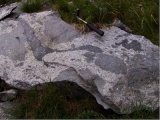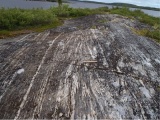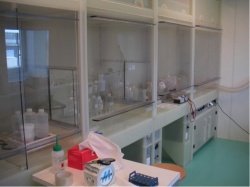Lowest-blank clean room facility for isotope analysis of accessory mineral grains
The class 100 clean-air facility is used for the chemical preparation of mineral grains for high-precision U-Pb geochronology, and trace element and Hf isotope analysis. Lowest levels of procedural Pb blanks allow precise isotope analysis of 1 pg of Pb from a variety of minerals (zircon, baddeleyite, monazite, xenotime, titanite, rutile, apatite) that have been dissolved previously in acids using Parr digestion vessels. All acids employed for U-Pb chemistry are distilled in-house and have blank levels of 100 fg Pb/ml or less. The laboratory is using Earthtime 205Pb-233U-235U and 202Pb-205Pb-233U-235U tracer solutions. Quality assessment is carried out by repeated analysis of Earthtime synthetic solutions (ET100, ET500, ET2000) as well as zircon reference materials, such as Plesovice, Temora, R33, GJ-1 and others.












